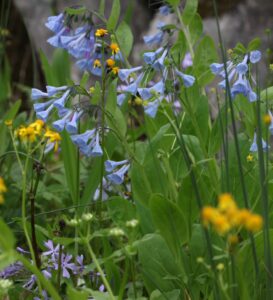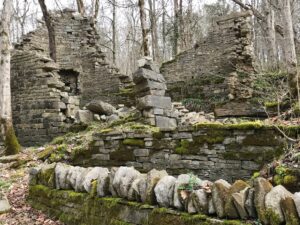This April, our Wild Ones chapter offers a spring wildflower hike at Lower Howards Creek, as we did last year. All winter long, the forest at the nature preserve has been a drab grey-brown. Then, quite suddenly, and before the trees have shown any real sign of new life, the forest floor greened up and colors appeared: white, blue, lavender and yellow. Responding to ample winter rains and to the warming sunlight of lengthening days, wildflowers have rushed into bloom, attracting pollinators and producing seed. When the trees will finally leaf out and shade the ground beneath, these flowers will have completed their reproductive cycle. Some will go entirely dormant with no trace of them remaining by June. Virginia bluebells are among those spring ephemerals. They grow here in stunning displays along the creek. It is hard to imagine that this valley was largely bare of trees 200 years ago. Lower Howards Creek was among the earliest areas in Kentucky occupied by European settlers starting in the 1770s, with Fort Boonesborough just 2 miles up the Kentucky river on its south side. There many early pioneers sheltered from the attacks of Indians who protected their hunting grounds from the intrusions of white people. Since the mid-eighteenth century, no native peoples had lived in Kentucky, but Shawnees and others came here regularly for seasonal hunts, mostly from across the Ohio river. The meat they procured in Kentucky substantially added to the food they harvested from the gardens around their villages up north.

By the early 1790s, the Indian communities in Ohio and Indiana were so weakened that they could no longer mount threatening incursions into Kentucky, and pioneer settlers began to farm and build homesteads in the open country including the Lower Howards Creek valley. They also established industries, above all grist mills, flower mills and saw mills, all powered by the swift running creek. Access roads were built for the customers of these businesses and their products. While all this development affected the natural ecosystem in and above the valley, the greatest impact occurred due to the deforestation of the valley. Wood was needed for everything: to build cabins, to mark off the new private properties with fences, to provide fuel for domestic and commercial use. But timber was also exported.


From about 1790 to the mid-eighteen hundreds, tobacco, flour, whiskey and other Kentucky products were shipped on flatboats down the Kentucky, Ohio and Mississippi rivers. Since the boats could not be brought back, they were disassembled in New Orleans and the lumber was sold. A boat yard for the building of these simple vessels stood on the Kentucky river close to the mouth of Lower Howards Creek. Its first owner and operator was John Holder, an early pioneer and military officer who had come to Fort Boonesborough in 1777. He participated in many raids against native Americans, became a major land speculator and eventually settled close to Lower Howards Creek. One of the trails in the preserve bears his name. European settlement of North America was extraordinarily destructive of the continent’s ecosystems and wasteful of its natural resources. The development of the Lower Howards Creek valley was no exception, a fact that we can easily forget as we marvel at one of nature’s great spectacles, namely the brief annual display of abundant wildflowers carpeting a forest floor. After the Civil War, when steam power replaced water as a source of energy, the valley’s economy declined. Its industries moved to higher ground near a railroad hub in Winchester and its roads fell in disuse. The forest regrew, though not to its former splendor. The wildflowers reasserted themselves, responding again to the old cycle of spring sunlight, summer shade and winter dormancy. Beate Popkin
